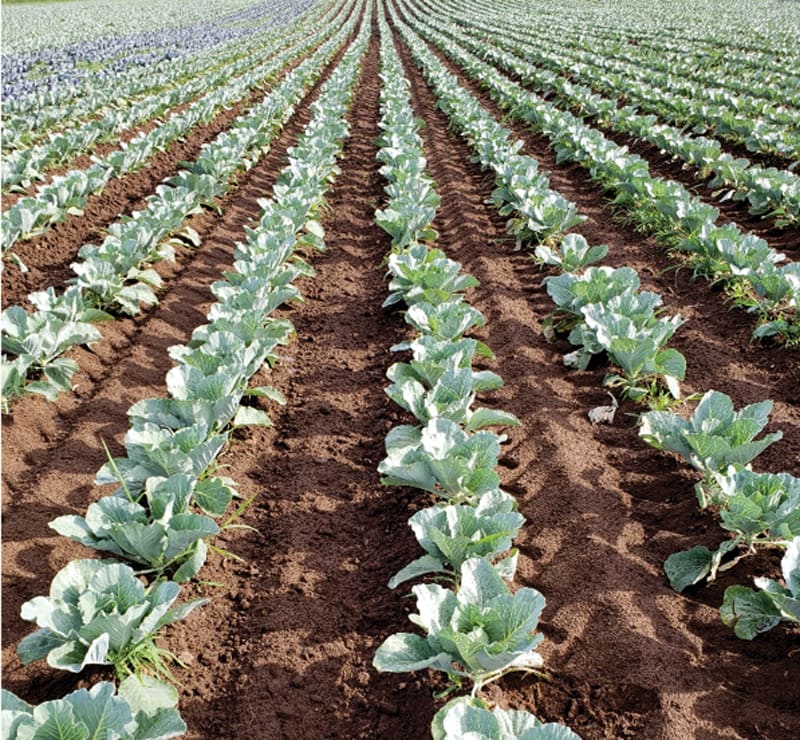The following article is based on Eric and Megan Wallendal's presentation at the 2018 National Strip-Tillage Conference. To watch other presentations from the event, click here.
Often, it’s the allure of operation-wide cost reduction that convinces farmers to transition into strip-tilling. But, on Wallendal Farms, strip-tilling since 1985, they’ve found a way to push revenues in addition to enjoying the efficiencies. Transitioning about 20% of their acres to certified organic production has allowed them to grow high-value specialty crops on some of their least productive fields.
While they still grow plenty of conventional crops, Megan Wallendal, and her husband, Eric, have found that the weed control benefits and targeted fertilizer applications of strip-tillage work particularly well for organics. Experimenting with high-value row crops (historically more than 35 different vegetables on the farm) and organic farming practices they’ve worked to evolve their 3,200-acre operation near Grand Marsh, Wis.
To build their strips, they use two 12-row Orthman 1tRIPr rigs, recently transitioning into a 22-inch system on nearly all of their strip-tilled acres. Wallendal says they converted their planters and tillage equipment to a 22-inch system for quicker plant canopy and row closure, along with more effective weed control and higher yields.
Their farm is comprised of mostly sandy soils with an average of 1% organic matter, under center pivot irrigation.
Due to certain limitations, farming organically comes with inherent costs — especially when it comes to inputs. Wallendal says the increased control over fertilizer placement in a strip-tilled system is especially important as those costs rise.
“Strip-till has been really important to us for organics, particularly, in terms of banding nutrients,” she says. “We’ve got crops that can’t always reach out for that 2-by-2-inch method. Banding becomes a lot more economical than broadcasting.”
Because all the inputs must be OMRI (Organic Materials Review Institute) approved, the Wallendals’ products are limited organic fertilizers like manure, fishmeal, compost and chicken litter.
“We band these about 2 gallons per acre,” she says. “The broadcast rates for those are about 10 gallons per acre. That’s a $56 per acre savings on just organic nutrients.”
Increasing demand is likely to help the market for organic crops continue to outpace the added costs it brings to the operation, Wallendal speculates.
“Our costs might increase 30-50% in some places, but our revenue is much higher,” she says. “Looking at organic markets today, I believe there’s around a 15-20% increase in demand, but the amount of land being transitioned in 2018 was only about 6% of that. That’s a huge gap, one that I think will be around for the next 10 years because it takes 3 full years to make that transition.”
Currently, 550 acres on the farm have been certified organic, with another 200 tied up in the 3-year transition phase.
Wallendal offers a few field-tested strategies for making a move toward organic and specialty crops in a strip-till system:
1. Transition Strategically
Though the transition to certified organic production on a given field generally takes 3 years, there are ways to be strategic, Wallendal says.
“We’ve selected some of our lowest performing fields, and transitioned those,” says Wallendal. “We weren’t making any money on them conventionally. They had the lowest organic matter and were just the poorest-looking and performing fields on our farm.”
For some farmers, locating a market for crops harvested from fields in transition to certified organic is possible, but even if it’s not, Wallendal notes that it’s still possible to time seasons for maximum gain.
“We weren’t able to find a market for transitional crops near us, in some locations with more industry or livestock that may be possible,” she says. “So we put our fields into cover crops for two seasons. When we’re ready for organic, we plant the crop at the beginning of the third season. It’s a 36-month transition so by the time we get to harvest in the third season, it would be certified organic.”
2. Locate a Market
Wallendal says finding a nearby organic farmer is a good start to getting a read on the local demand for certified organic crops. Local market information can also provide guidance on what crops to introduce.
“There’s not a huge market for organic rye because there’s a lot of people growing it,” she says. “Wheat is better. Some specialty grains are better, too. Corn, soy and specialty grains are where we’re finding the best contracts right now.”
Eventually, the market may come to the farmer, she adds. “We have contractors coming to us saying, ‘We hear you’ve got organic ground, can you grow this?’” Wallendal says. “We can then find those higher paying contracts and charge a premium.

DIVERSITY DIVIDENDS. Experimenting with high-value organic row crops, historically more than 35 different vegetables on the farm, including cabbage, Megan Wallendal says increasing demand is likely to help the market for organic crops continue to outpace the added costs it brings to their operation.
“We even shipped some grain to Canada and Michigan in 2018, because they don’t have enough certified organic ground around them, they’ll pay a premium that covers our trucking costs.”
3. Partner Patience
Most of the Wallendals’ organic crops are contracted before they’re planted. For instance, their snap beans and sweetcorn are contracted with Del Monte Foods and Hartung Brothers Inc., and Chippewa Valley Bean has a contract on their dark red kidney beans.
Despite being certified, sometimes the buyers need a bit of convincing that strip-tilling is effective. Wallendal says this can be done with small test fields.
“About 4 years ago they (Hartung) wouldn’t allow us to plant their beans in 22-inch rows or strip-till, because they didn’t understand it,” she says. “Working with their field man, we took a 5-acre portion and just did it our way. We wanted the field man coming out every week to look at it to really get him on board and really believing in our practices. After inundating them with more information and research articles on it, they ended up giving us the go ahead.”
4. Control Weeds
Wallendal says the biggest issue with strip-tilled certified organic crops is weed pressure. Because of the challenges created by herbicide restrictions on organics, they’ve had to get creative to choke out weeds naturally.
For this purpose, they use a roller-crimper, leaving heavy residue in rows.
Specifically, for crops that need a heavy “mat” like pumpkins, Wallendal uses an ‘Aroostook’ rye variety from Maine as a cover crop. The variety goes through anthesis (pollen shed) about 10 days before a typical cereal rye in Wisconsin would, so she’s able to use a roller crimper on it sooner.
“We go in and strip-till when it’s about 4 inches high,” Wallendal says. “When it gets to 8-12 inches, we’ll strip it again. Then after we roller-crimp it, we’ll strip-till one more time. That’s early June though, so it is a later system, but we’re starting to do this with our soybeans as well because the weed control is so amazing. We’re finding 1-2% weed occurrence and the only herbicide we’ve put down is a pre-emerge, a mix of Sandea and glyphosate for some burndown.”
Though strip-tilling into the cover crop 3 times felt like a lot, a brief experiment with only 2 passes in 2017 convinced Wallendal that all 3 passes were necessary to properly prepare the seedbed.
Purposely treating cover crops themselves like a cash crop has gone a long way toward helping them “crimp nicely,” Wallendal says.
“In fall, we water the cereal rye and in the spring we’ll give it a shower of nutrients and more water,” she added. “We’ll apply a little 32% nitrogen (N) through the center pivot irrigator and spread some Calsol on it as well.”
Leaving heavy residue in rows has also been helpful to choke out weeds.
“Leaving the residue in the row really helps. We have to use a tine harrow a lot in our soybeans, corn and dry beans, so we’re planting a higher population,” she says.
Even small improvements to their weeding program on organic acres pay dividends.
“Once the crops are a little bigger, we can’t use a tine harrow, so we have a finger weeder that’s able to get right near the plant,” says Wallendal. “It’s been really helpful because we still have to budget hand weeding into our costs of production.
“That usually ends up being about $150 per-acre in our organic crops. We haven’t reached that every year, and that’s due to a lot of the cultivation practices we’re using to reduce costs.”







